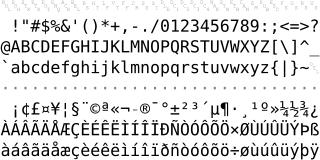Related Research Articles

ISO/IEC 8859-1:1998, Information technology — 8-bit single-byte coded graphic character sets — Part 1: Latin alphabet No. 1, is part of the ISO/IEC 8859 series of ASCII-based standard character encodings, first edition published in 1987. ISO/IEC 8859-1 encodes what it refers to as "Latin alphabet no. 1", consisting of 191 characters from the Latin script. This character-encoding scheme is used throughout the Americas, Western Europe, Oceania, and much of Africa. It is the basis for some popular 8-bit character sets and the first two blocks of characters in Unicode.
ISO/IEC 8859-3:1999, Information technology — 8-bit single-byte coded graphic character sets — Part 3: Latin alphabet No. 3, is part of the ISO/IEC 8859 series of ASCII-based standard character encodings, first edition published in 1988. It is informally referred to as Latin-3 or South European. It was designed to cover Turkish, Maltese and Esperanto, though the introduction of ISO/IEC 8859-9 superseded it for Turkish. The encoding was popular for users of Esperanto, but fell out of use as application support for Unicode became more common.

Windows-1252 or CP-1252 is a single-byte character encoding of the Latin alphabet that was used by default in Microsoft Windows for English and many Romance and Germanic languages including Spanish, Portuguese, French, and German. This character-encoding scheme is used throughout the Americas, Western Europe, Oceania, and much of Africa.
ISO/IEC 8859-11:2001, Information technology — 8-bit single-byte coded graphic character sets — Part 11: Latin/Thai alphabet, is part of the ISO/IEC 8859 series of ASCII-based standard character encodings, first edition published in 2001. It is informally referred to as Latin/Thai. It is nearly identical to the national Thai standard TIS-620 (1990). The sole difference is that ISO/IEC 8859-11 allocates non-breaking space to code 0xA0, while TIS-620 leaves it undefined.
ISO/IEC 8859-8, Information technology — 8-bit single-byte coded graphic character sets — Part 8: Latin/Hebrew alphabet, is part of the ISO/IEC 8859 series of ASCII-based standard character encodings. ISO/IEC 8859-8:1999 from 1999 represents its second and current revision, preceded by the first edition ISO/IEC 8859-8:1988 in 1988. It is informally referred to as Latin/Hebrew. ISO/IEC 8859-8 covers all the Hebrew letters, but no Hebrew vowel signs. IBM assigned code page 916 to it. This character set was also adopted by Israeli Standard SI1311:2002, with some extensions.
ISO/IEC 8859-5:1999, Information technology — 8-bit single-byte coded graphic character sets — Part 5: Latin/Cyrillic alphabet, is part of the ISO/IEC 8859 series of ASCII-based standard character encodings, first edition published in 1988. It is informally referred to as Latin/Cyrillic.
ISO/IEC 8859-6:1999, Information technology — 8-bit single-byte coded graphic character sets — Part 6: Latin/Arabic alphabet, is part of the ISO/IEC 8859 series of ASCII-based standard character encodings, first edition published in 1987. It is informally referred to as Latin/Arabic. It was designed to cover Arabic. Only nominal letters are encoded, no preshaped forms of the letters, so shaping processing is required for display. It does not include the extra letters needed to write most Arabic-script languages other than Arabic itself.
ISO/IEC 8859-7:2003, Information technology — 8-bit single-byte coded graphic character sets — Part 7: Latin/Greek alphabet, is part of the ISO/IEC 8859 series of ASCII-based standard character encodings, first edition published in 1987. It is informally referred to as Latin/Greek. It was designed to cover the modern Greek language. The original 1987 version of the standard had the same character assignments as the Greek national standard ELOT 928, published in 1986. The table in this article shows the updated 2003 version which adds three characters. Microsoft has assigned code page 28597 a.k.a. Windows-28597 to ISO-8859-7 in Windows. IBM has assigned code page 813 to ISO 8859-7. (IBM CCSID 813 is the original encoding. CCSID 4909 adds the euro sign. CCSID 9005 further adds the drachma sign and ypogegrammeni.)
ISO/IEC 8859-9:1999, Information technology — 8-bit single-byte coded graphic character sets — Part 9: Latin alphabet No. 5, is part of the ISO/IEC 8859 series of ASCII-based standard character encodings, first edition published in 1989. It is designated ECMA-128 by Ecma International and TS 5881 as a Turkish standard. It is informally referred to as Latin-5 or Turkish. It was designed to cover the Turkish language, designed as being of more use than the ISO/IEC 8859-3 encoding. It is identical to ISO/IEC 8859-1 except for the replacement of six Icelandic characters with characters unique to the Turkish alphabet. And the uppercase of i is İ; the lowercase of I is ı.
KOI8-R is an 8-bit character encoding, derived from the KOI-8 encoding by the programmer Andrei Chernov in 1993 and designed to cover Russian, which uses a Cyrillic alphabet. KOI8-R was based on Russian Morse code, which was created from a phonetic version of Latin Morse code. As a result, Russian Cyrillic letters are in pseudo-Roman order rather than the normal Cyrillic alphabetical order. Although this may seem unnatural, if the 8th bit is stripped, the text is partially readable in ASCII and may convert to syntactically correct KOI-7. For example, "Русский Текст" in KOI8-R becomes rUSSKIJ tEKST.
KOI8-U is an 8-bit character encoding, designed to cover Ukrainian, which uses a Cyrillic alphabet. It is based on KOI8-R, which covers Russian and Bulgarian, but replaces eight box drawing characters with four Ukrainian letters Ґ, Є, І, and Ї in both upper case and lower case.

Code page 850 is a code page used under DOS operating systems in Western Europe. Depending on the country setting and system configuration, code page 850 is the primary code page and default OEM code page in many countries, including various English-speaking locales, whilst other English-speaking locales default to the hardware code page 437.
Windows-1250 is a code page used under Microsoft Windows to represent texts in Central European and Eastern European languages that use the Latin script. It is primarily used by Czech, though Czech has now moved to UTF-8 and mostly abandoned this legacy encoding. It is also used for Polish, Slovak, Hungarian, Slovene, Serbo-Croatian, Romanian, Rotokas and Albanian. It may also be used with the German language, though it's missing uppercase ẞ. German-language texts encoded with Windows-1250 and Windows-1252 are identical.
Windows code page 1253, commonly known by its IANA-registered name Windows-1253 or abbreviated as cp1253, is a Microsoft Windows code page used to write modern Greek. It is not capable of supporting the older polytonic Greek.
Windows-1254 is a code page used under Microsoft Windows, to write Turkish that it was designed for. Characters with codepoints A0 through FF are compatible with ISO 8859-9, but the CR range, which is reserved for C1 control codes in ISO 8859, is instead used for additional characters. It matches Windows-1252 except for the replacement of six Icelandic characters with characters unique to the Turkish alphabet.
Windows-1255 is a code page used under Microsoft Windows to write Hebrew. It is an almost compatible superset of ISO-8859-8 – most of the symbols are in the same positions, but Windows-1255 adds vowel-points and other signs in lower positions.
Windows-1256 is a code page used under Microsoft Windows to write Arabic and other languages that use Arabic script, such as Persian and Urdu.
Windows-1257 is an 8-bit, single-byte extended ASCII code page used to support the Estonian, Latvian and Lithuanian languages under Microsoft Windows. In Lithuania, it is standardised as LST 1590-3, alongside a modified variant named LST 1590-4.
KOI8-RU is an 8-bit character encoding, designed to cover Russian, Ukrainian, and Belarusian which use a Cyrillic alphabet. It is closely related to KOI8-R, which covers Russian and Bulgarian, but replaces ten box drawing characters with five Ukrainian and Belarusian letters Ґ, Є, І, Ї, and Ў in both upper case and lower case. It is even more closely related to KOI8-U, which does not include Ў but otherwise makes the same letter replacements. The additional letter allocations are matched by KOI8-E, except for Ґ which is added to KOI8-F.
Code page 922 is a code page used under IBM AIX and DOS to write the Estonian language. It is an extension and modification of ISO/IEC 8859-1, where the letters Ð/ð and Þ/þ used for Icelandic are replaced by the letters Š/š and Ž/ž respectively. This matches the encoding of these letters in Windows-1257 and ISO/IEC 8859-13.